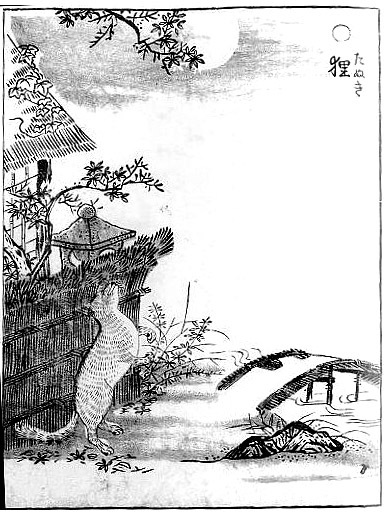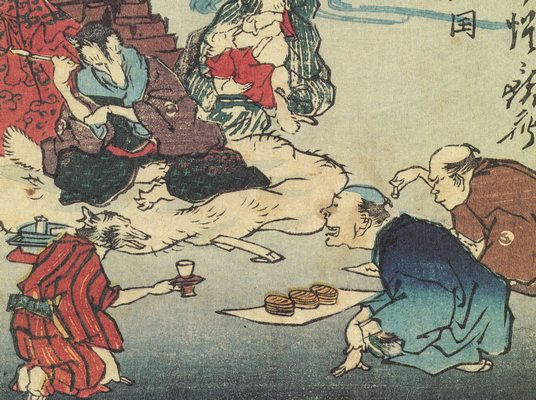|
Shibaemon-tanuki
Shibaemon-tanuki, or Shibaemon-danuki (иЉқеЏіиҰ›й–Ђз‹ё or жџөеЏіиҰ›й–Ђз‹ё) is a bake-danuki told in the legends of Awaji island, HyЕҚgo Prefecture.жқ‘дёЉ2000е№ө 182-183й ЃгЂ‚ Along with Danzaburou-danuki of Sado island and the Yashima no Hage-tanuki of Kagawa Prefecture, he is counted among the "three famous tanuki of Japan." He is also written about in the colorful stories collection of the Edo period, the Ehon Hyaku Monogatari.е¤љз”°з·Ё1997е№ө 62-63й ЃгЂ‚ While disguised as a human and in the middle of performing an act, he was attacked by a dog and killed, but the details of the tale differ depending on region and literature. Legend in the HyЕҚgo prefecture While Shibaemon-tanuki was at the summit of Mt. Mikuma (дё‰з†Ље±±) behind the city of Sumoto, Awaji island, he lived with his wife Omasu (гЃЉеұ—) and on moonlight nights with good weather, he drummed his belly. He performed mischief such as disguising himself as a human and making tree leaves seem like gold and sell them, b ... [...More Info...] [...Related Items...] OR: [Wikipedia] [Google] [Baidu] |
Yashima No Hage-tanuki
is a , who appears in the legends of Yashima, Takamatsu, Kagawa Prefecture. He is also called TasaburЕҚ-tanuki (е¤Ғдё‰йѓҺз‹ё), Yashima no Hage, and Yashima no Kamuro (屋島のз¦ү). He is counted as one of the "three famous tanuki of Japan", along with Danzaburou-danuki of Sado and Shibaemon-tanuki of Awaji. He is also famous due to his appearance in the Studio Ghibli animated movie, '' Heisei Tanuki Gassen Ponpoko''. жқ‘дёЉ2011е№өгЂЃ126-127й ЃгЂ‚ Legend In the past, there was a tanuki who was wounded by a fatal arrow shot, but was saved by Taira no Shigemori. To pay his debt of gratitude, the tanuki swore to protect the Taira clan. This wounded tanuki's descendant is said to be Yashima no Hage-tanuki. 赤еҰљ1995е№өгЂЃ99–100й ЃгЂ‚ After the Taira clan was ruined, Hage-tanuki became the protector deity of Yashima-ji, the 84th temple on the Shikoku 88-temple pilgrimage. His skill at transformation was called the best in Japan, and he achieved the rank of supreme commander of ... [...More Info...] [...Related Items...] OR: [Wikipedia] [Google] [Baidu] |
Ehon Hyaku Monogatari
The , also called the is a book of ''yЕҚkai'' illustrated by Japanese artist Takehara Shunsensai, published about 1841. The book was intended as a followup to Toriyama Sekien's ''Gazu Hyakki YagyЕҚ'' series. Like those books, it is a supernatural bestiary of ghosts, monsters, and spirits which has had a profound influence on subsequent yЕҚkai imagery in Japan. The author's pen name is ; however, in the preface it is written as . According to the '' Kokusho SЕҚmokuroku'' (Iwanami Shoten) this is considered to be a gesaku author from the latter half of the Edo period, . It can be said that this is a kind of hundred-tale ''kaidan'' (ghost story) book popular in the Edo period, as "100 Tales" is part of the title, but rather than being tales with story titles, yЕҚkai names are printed with illustrations of yЕҚkai, so it could be said that this work is a fusion of kaidan book and picture book. This book is also known by the title ''TЕҚsanjin Yawa'' because the title on the first pa ... [...More Info...] [...Related Items...] OR: [Wikipedia] [Google] [Baidu] |
Bake-danuki
''Bake-danuki'' () are a kind of ''yЕҚkai'' (supernatural beings) found in the classics and in the folklore and legends of various places in Japan, commonly associated with the Japanese raccoon dog or ''tanuki''. Although the ''tanuki'' is a real, extant animal, the ''bake-danuki'' that appears in literature has always been depicted as a strange, even supernatural animal. The earliest appearance of the ''bake-danuki'' in literature, in the chapter about Empress Suiko in the '' Nihon Shoki'' written during the Nara period, there are such passages as "in two months of spring, there are tanuki in the country of Mutsu (), they turn into humans and sing songs ()." Bake-danuki subsequently appear in such classics as the Nihon RyЕҚiki and the Uji ShЕ«i Monogatari. In some regions of Japan, ''bake-danuki'' are reputed to have abilities similar to those attributed to ''kitsune'' (foxes): they can shapeshift into other things or people, and can possess human beings. Many legends of ''tanuk ... [...More Info...] [...Related Items...] OR: [Wikipedia] [Google] [Baidu] |
Awa Tanuki Gassen
The (also called the or the ) is a Japanese legend that takes place in the Awa Province (now Tokushima Prefecture). The legend is about a great war between two ''tanuki ''powers. There are several well-known tales about tanuki in Shikkoku, and this one is said to be the most famous among those from Tokushima. This story first appeared near the end of the Edo Period, and in literature, it was first published in Meiji 43 (1910) under the title "Shikoku Kidan Jissetsu Furudanuki Gassen" (е››е›ҢеӨ‡и«‡е®џиҒ¬еЏ¤з‹ёеђ€ж€¦). It was a kЕҚdan from the Meiji period until the time of the war and gained popularity in the beginning of the Showa period as it became depicted in movies. In the Heisei period, it has become a common theme in community development and is widely known in Tokushima Prefecture. Legend The story took place around the tenpЕҚ period (from 1830 to 1844) near Higaino in Komatsushima (now Higaino-chЕҚ in the city of Komatsushima, Tokushima). A dyer named Moemon (иЊ‚еЏіиҰ ... [...More Info...] [...Related Items...] OR: [Wikipedia] [Google] [Baidu] |
List Of Legendary Creatures From Japan
The following is a list of demons, ghosts, and other legendary creatures that are notable in Japanese folklore and mythology. A B C D E F G H I J K M N O R S T ... [...More Info...] [...Related Items...] OR: [Wikipedia] [Google] [Baidu] |
Danzaburou-danuki
is a bake-danuki passed down in stories on Sado Island, particularly in Aikawa and Niigata. In Sado, tanuki were called "mujina (з‹ұ)", thus he was also referred to as Danzaburou-mujina (е›Әдё‰йѓҺз‹ұ). In the Ukiyo-e, its name was written as еђЊдё‰з‹ё." Together with the Shibaemon-tanuki of Awaji Island, and the Yashima no Hage-tanuki of Kagawa, they form the " three famous tanuki" of Japan. Legend The supreme commander of the tanuki on Sado Island, most tales of Danzaburou focus on his trickery of humans. He would create wall-like structures to block people's paths at night, fooled people with mirages and sold leaves from trees by making them look as if they were made of gold. He also created mirages to lure people into his lair (said to be a hole in the ground or a cellar), making it appear as a splendid estate. If he ever became ill, Danzaburou would disguise himself as a human and visit human doctors for treatment. His reputation was not all bad, however. He was said to ha ... [...More Info...] [...Related Items...] OR: [Wikipedia] [Google] [Baidu] |
Sado Island
is a city located on in Niigata Prefecture, Japan. Since 2004, the city has comprised the entire island, although not all of its total area is urbanized. Sado is the sixth largest island of Japan in area following the four main islands and Okinawa Island (excluding the Northern Territories). As of March 1, 2022, the city has an estimated population of 49,897 and a population density of 58.3 persons per square kilometre. The total area is 855.69 km2. History Political formation of the island The large number of pottery artifacts found near Ogi in the South of the island demonstrate that Sado was populated as early as the JЕҚmon period. The '' Nihon Shoki'' mentions that Mishihase people visited the island in 544 (although it is unknown whether Tungusic people effectively came). The island formed a distinct province, the Sado Province, separate from the Echigo province on HonshЕ«, at the beginning of the 8th century. At first, the province was a single ''gun'' (district ... [...More Info...] [...Related Items...] OR: [Wikipedia] [Google] [Baidu] |
Kagawa Prefecture
is a prefecture of Japan located on the island of Shikoku. Kagawa Prefecture has a population of 949,358 (as of 2020) and is the smallest prefecture by geographic area at . Kagawa Prefecture borders Ehime Prefecture to the southwest and Tokushima Prefecture to the south. Takamatsu is the capital and largest city of Kagawa Prefecture, with other major cities including Marugame, Mitoyo, and Kan'onji. Kagawa Prefecture is located on the Seto Inland Sea across from Okayama Prefecture on the island of Honshu, which is connected by the Great Seto Bridge. Kagawa Prefecture includes ShЕҚdoshima, the second-largest island in the Seto Inland Sea, and the prefecture's southern land border with Tokushima Prefecture is formed by the Sanuki Mountains. History Kagawa was formerly known as Sanuki Province. For a brief period between August 1876 and December 1888, Kagawa was made a part of Ehime Prefecture. Battle of Yashima Located in Kagawa's capital city, Takamatsu, the mounta ... [...More Info...] [...Related Items...] OR: [Wikipedia] [Google] [Baidu] |
Edo Period
The or is the period between 1603 and 1867 in the history of Japan, when Japan was under the rule of the Tokugawa shogunate and the country's 300 regional '' daimyo''. Emerging from the chaos of the Sengoku period, the Edo period was characterized by economic growth, strict social order, isolationist foreign policies, a stable population, perpetual peace, and popular enjoyment of arts and culture. The period derives its name from Edo (now Tokyo), where on March 24, 1603, the shogunate was officially established by Tokugawa Ieyasu. The period came to an end with the Meiji Restoration and the Boshin War, which restored imperial rule to Japan. Consolidation of the shogunate The Edo period or Tokugawa period is the period between 1603 and 1867 in the history of Japan, when Japan was under the rule of the Tokugawa shogunate and the country's regional '' daimyo''. A revolution took place from the time of the Kamakura shogunate, which existed with the TennЕҚ's court, to the Tok ... [...More Info...] [...Related Items...] OR: [Wikipedia] [Google] [Baidu] |
Sumoto, HyЕҚgo
270px, Sumoto City Hall 270px, Sumoto Castle is a city located on Awaji Island, HyЕҚgo Prefecture, Japan. , the city had an estimated population of 42,094 and a population density of 230 persons per kmВІ.The total area of the city is . Geography The city of Sumoto occupies the middle of Awaji Island, sandwiched between Awaji and Minamiawaji. with the Gulf of Harima on the Seto Inland Sea to the west and Osaka Bay to the east. The Sumoto River flows into Osaka Bay in the center of the city area, part of which are within the borders of the Setonaikai National Park Surrounding municipalities Hyogo Prefecture * Awaji * Minamiawaji Climate Sumoto has a humid subtropical climate (KГ¶ppen climate classification ''Cfa'') with hot summers and cool winters. Precipitation is significant throughout the year, but is somewhat lower in the winter. Demographics Per Japanese census data, the population of Sumoto has been declining steadily over the past 60 years. History The city of ... [...More Info...] [...Related Items...] OR: [Wikipedia] [Google] [Baidu] |
Naka No Shibai
Naka no Shibai (дёгЃ®иЉқе±…, Central Theatre), also known as Naka-za (дёеғ§), was one of the major kabuki theatres in Osaka, Japan. History It was first built in 1652, in Osaka's DЕҚtonbori entertainment district, and saw the premieres of many famous plays; closely related to the nearby '' jЕҚruri'' theatres, Naka would often be the first to adapt puppet plays to the kabuki stage, and often also arranged the Kamigata (Kansai) premieres of plays earlier performed in Edo. Also tied closely to other theatres in the area, and the general theatre culture and community of Kamigata, Naka hosted a number of competitions between actors and troupes, as well as reconciliation ceremonies between actors who had been feuding, and a variety of other theatrical community events. Some of the plays premiered at the Naka no Shibai include '' Natsu Matsuri Naniwa Kagami'' (1745), ''Yoshitsune Senbon Zakura'' (Aug. 1748), and ''Kanadehon ChЕ«shingura'' (Dec. 1748) which was first performed as a pup ... [...More Info...] [...Related Items...] OR: [Wikipedia] [Google] [Baidu] |




.png)